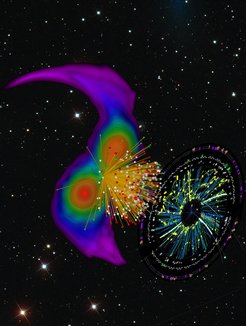Combination of heavy-ion experiments, astronomy, and theory offers new insights
Constraining neutron-star matter with microscopic and macroscopic collisions
For the first time, an international research team, including researchers from the Max Planck Institute for Gravitational Physics (Albert Einstein Institute) and Potsdam University has combined data from nuclear physics experiments, gravitational-wave measurements and other astronomical observations with theoretical insights to more precisely constrain how nuclear matter behaves inside neutron stars. The results were published in the scientific journal Nature today.

Neutron stars are born in supernova explosions that mark the end of the life of massive stars. Sometimes neutron stars are bound in binary systems and will eventually collide with each other. These high-energy, astrophysical phenomena feature such extreme conditions that they produce most of the heavy elements, such as silver and gold. Consequently, neutron stars and their collisions are a unique laboratory to study the properties of matter at densities far beyond the densities inside atomic nuclei. Heavy-ion collision experiments conducted with particle accelerators are a complementary way to produce and probe matter at high densities and under extreme conditions.
“Combining knowledge from nuclear theory, nuclear experiment, and astrophysical observations is essential to shedding light on the properties of neutron-rich matter over the entire density range probed in neutron stars,” said Sabrina Huth from Technical University Darmstadt, who is one of the lead authors of the publication. Peter T. H. Pang, another lead author from the Institute for Gravitational and Subatomic Physics (GRASP), Utrecht University, added, “We find that constraints from collisions of gold ions in particle colliders show a remarkable consistency with astrophysical observations even though they are obtained with completely contrary methods.”
“Over the last years, we have developed accurate models that allow us to extract the properties of the neutron stars from the observed gravitational-wave data. This is a key aspect of a reliable multi-messenger interpretation”, says Tim Dietrich, Professor at Potsdam University and Leader of a Max Planck Fellow Group at the Max Planck Institute for Gravitational Physics (Albert Einstein Institute).
Recent progress in multi-messenger astronomy allowed the international research team, involving researchers from Germany, the Netherlands, the US, and Sweden to open up a new field to improve and complete the fundamental understanding of nuclear forces. In an interdisciplinary effort, the researchers included information obtained in heavy-ion collisions into a framework combining astronomical observations of electromagnetic signals, measurements of gravitational waves, and high-performance astrophysics computations with theoretical nuclear-physics calculations. Their systematic study combines all these individual disciplines for the first time.
The authors incorporated the information from gold-ion collision experiments performed at GSI in Darmstadt as well as at the Brookhaven National Laboratory and the Lawrence Berkeley National Laboratory in the USA in their multi-step procedure that analyzes constraints from nuclear theory and astrophysical observations, including neutron star mass measurements through radio observations, information from rapidly spinning neutron stars gained in the Neutron Star Interior Composition Explorer (NICER) mission on the International Space Station (ISS), and multi-messenger observations of binary neutron star mergers.
New information from laboratory experiments, astronomical observations, or theory can easily be included in the framework to further improve our understanding of dense matter in the coming years. New gravitational-wave observations will be possible from late 2022 with the next observing run of the international detector network. “We are living in exciting times in which it becomes possible to directly compare nuclear physics computations and experiments with astrophysical modeling and observations. In late 2022, the existing gravitational-wave detectors will start their next observing runs and we can hope for a few more multi-messenger detections of merging neutron stars. These data will pave the way for a better understanding of supranuclear dense matter and it will allow us to perform interdisciplinary studies with unprecedented accuracy”, says Tim Dietrich.












